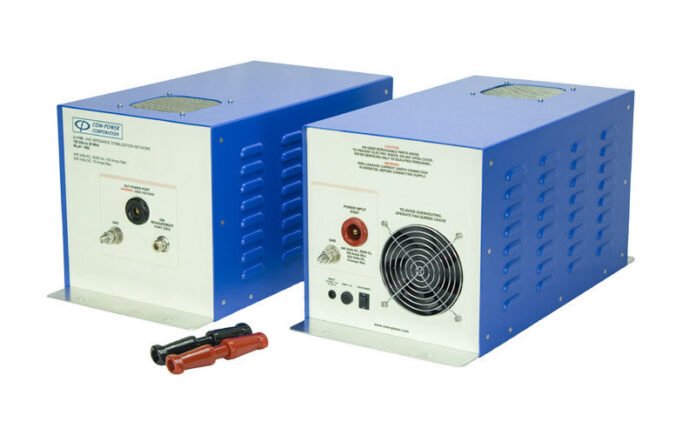Line Impedance Stabilisation Networks (LISNs) are used to measure conducted emissions on power lines. The LISN draws power from the ordinary wall outlet and feeds this to the equipment under test (EUT). Any RF noise generated by the EUT is separated by the LISN and fed to the spectrum analyser for measurement or recording.
What functions do LISNs perform?
LISNs perform a number of important functions, explained below by our technical partner, Com-Power Corporation:
Stable Line Impedance
The first function of a LISN is to provide stable, normalised impedance on the power line. This function is important as the power line impedance through a standard wall outlet can vary greatly, depending on how and where the wiring is connected.
The amount of EUT noise present at the LISN measurement port is directly related to the impedance of the power line versus the impedance of the EUT. These two impedances effectively create a voltage divider network for the EUT noise, allowing only a fraction of the noise voltage to reach the measurement port. Therefore, the ability to achieve reliable and consistent measurement results depends highly on the reliability and consistency of the LISN impedance during the test.
Prevents external noise coupling in
The second important function of a LISN is to isolate the external noise which may be present on the power line. For example, a LISN with a 50 micro-Henry inductance presents a high impedance to the outside RF noise while allowing the lower frequency power to flow through to the EUT. The first 1.0 microfarad line to ground capacitor forms the first stage of a two-stage filter, working with the inductor accomplish this goal.
Suitable connection to the measuring equipment
A spectrum Analyser or EMI receiver is typically used as the measuring meter for this test. The input stage of these devices is very sensitive, and liable to damage. The LISN is designed to allow the low-level RF noise from the EUT to easily couple through the capacitor to the input of the measuring meter, while the resistor reduces the low frequency power line voltage.
Why so many different LISNs?
Different LISNs are needed to meet the various EMC test standards such as CISPR, FCC, ISO, EN, RTCA DO-160 and MIL-STD 461D. Different standards require different test frequencies as they take into account the operating environment for the types of equipment covered by each standard.
For example, for CISPR 16-1-2 a 50 micro-henry LISN would be used to test in the range of 150 kHz to 30 MHz. However, if the testing required begins at 10 kHz, a two stage circuit is needed with an additional L-section comprised of a 250 micro-Henry inductor and an 8-microfarad capacitor. This LISN with the extra filter works better in the 10 kHz to 150 kHz region than the single stage circuit 50 micro-Henry LISN.
The value of the inductor is also based on the anticipated inductance of the power line for the intended installation of the product. In addition, higher EUT current requirements require higher current handling components, which add to the variety of LISNs needed.
Operating voltages may also be a reason for additional models of LISNs. LISNs are made for AC voltage operation as well as DC. The working voltage levels also may be different. Finally, the number of phases in the power supply may require more variations in the LISN types.
Further information on LISNs
The information in this article has been sourced from the Com-Power Application Note AN-105LISN. You can read the application note by following the link below.
Com-Power offers a line of LISNs developed for conducted emission testing according to the most commonly adopted EMC specifications.






